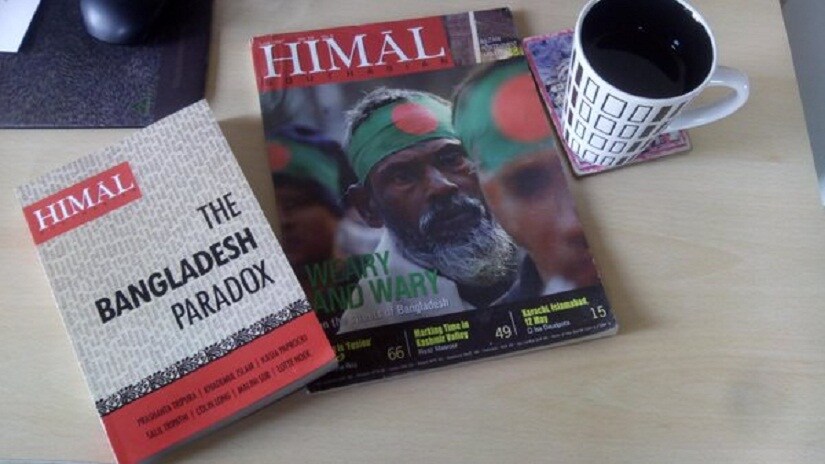On 24 August, a message appeared on the website of the Himal Southasian, a magazine that had provided a distinctive voice for reporting from this region from 1996 (it had been around since 1987, but as a Himalayan journal). The message from S Mishra, member-secretary of executive board of The Southasia Trust (the non-profit entity that publishes the magazine) said that in the face of overwhelming non-cooperation from regulatory state agencies in Nepal, Himal was forced to close down operations. The last issue (until such time as the team can resume publication in more favourable circumstances) would be in November 2016, the message stated. Read the complete message about Himal Southasian’s closure here. Himal Southasian’s closure comes months after its editor and founder Kanak Mani Dixit was arrested for allegedly holding wealth “disproportionate to his sources of income”. _Read Firstpost's report here — Kind, gentle and fearless: Kanak Mani Dixit's arrest on corruption charges is absurd_ [caption id=“attachment_2988836” align=“alignnone” width=“825”]  Himal Southasian provided distinctive reportage from the Indian subcontinent. Photo courtesy Twitter[/caption] Himal Southasian, as mentioned above, provided a distinctive view of the Indian subcontinent. At a time during when the press has accused of parking its conscience behind algorithms rather than stories, Himal defied what can now be considered as exacting your influence. It held aloft now-fossilised ideals of journalism, the shadows of which may soon be the meter with which we assert our failings. In what could now turn out to be my only contribution to the magazine, I found in the editors a gaze, a kind of patient energy, that is perhaps necessary to shape the reporting of amateurs and at times, even experienced journalists. Himal’s presence on the shelf of a library (be it at a mass media college) was a soothing reflection of the world we all want to report from, on our resumes, but are more than happy to avoid on our passports. In an ideal space, where storytelling merges with fact, there is more than just the facet, but also a body, a head, and the eyes of a story — by eyes I mean that self-referencing guilt, the first person accounts that magnetise visual detail. And within that space, the magazine had carved an identity for itself. One of the greatest strengths of Himal was its emphasis on culture, an entry point that most media has given up on in terms of their reporting. In its unique ability to rise to a level from where the subcontinent could both be interpreted and dissected, the magazine was in essence the emergence of a new world-view not enslaved by self-identifications of the local media. In that sense Himal is perhaps even a collector’s item. I remember reading Himal’s ‘Labour’ issue and wondering to myself, where if anywhere else, had I read such in-depth reportage on a side of the subcontinent which would otherwise be referenced only in dossiers distributed at Human Rights conventions. Who serves democracy better than the one who finds fault in its implementation? If all tailors were kings, not all men would get to wear suits. And there it was, tucked in my imagination, somewhere in a country I haven’t even visited, a tailor weaving his stories and helping us weave ours, to put into context this globally smudged account of our interrupted lives. It is no less than abuse, of not only power but diligence in the way forces (national or anti-national) claim our only outpost for reconnaissance on a human level. Journalism, like everything else now, has a nationality which decides what it may or may not amount to. From publishing poetry to reporting that questioned the status quo, Himal surrendered to no one and continued undeterred by the cultural dispensation that now dictates what we may or may not be interested in. The format of recent events in connection to the magazine is what most vituperative accounts of power are made of. In the agency of the state, we can now identify with the monsters that we, as children, feared we’d create. Journalism is a labour of love. It is the unmatched account of half a life, with each half at all times looking at the other in search of an egress, the political milieu of which is defined not by what you stand for, but what you stand against. And Himal stood against a fair number of things. Journalists are after all, born and raised on the precipice of hopelessness. In between the margins they find purpose and at times even sanity. But alliances that are now being forged on devices set on failure have found a way to push the journalist into oblivion. And soon — sooner than you think — we’ll be adopting the many failings that oblivion is made of, and without Himal and its like to guide us through that dark time, we may come to rue our own ideas. Of course the magazine could come back — and it should, because we are going to need it more than it needs us.
The closure of the Himal Southasian goes beyond the end of a magazine. It marks the end of everything this distinctive publication stood for.
Advertisement
End of Article


)
)
)
)
)
)
)
)
)



